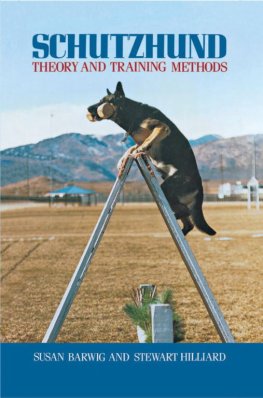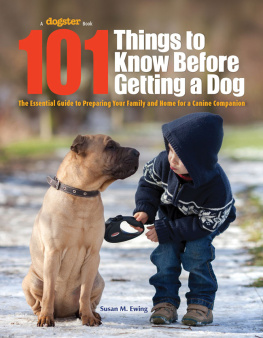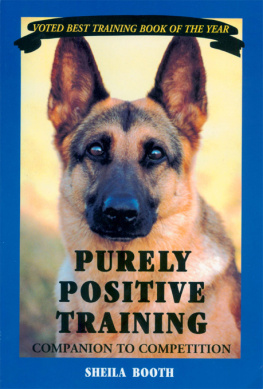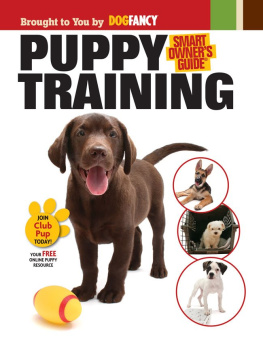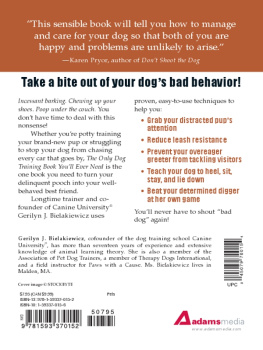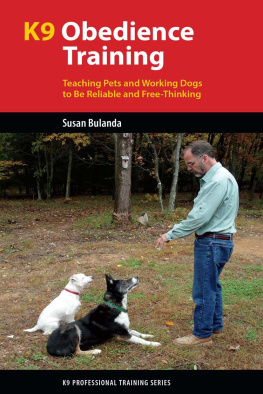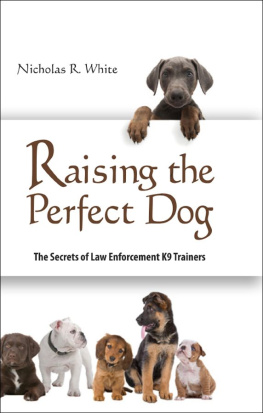Susan Barwig - Schutzhund
Here you can read online Susan Barwig - Schutzhund full text of the book (entire story) in english for free. Download pdf and epub, get meaning, cover and reviews about this ebook. City: New York, year: 1991, publisher: Howell Book House, genre: Home and family. Description of the work, (preface) as well as reviews are available. Best literature library LitArk.com created for fans of good reading and offers a wide selection of genres:
Romance novel
Science fiction
Adventure
Detective
Science
History
Home and family
Prose
Art
Politics
Computer
Non-fiction
Religion
Business
Children
Humor
Choose a favorite category and find really read worthwhile books. Enjoy immersion in the world of imagination, feel the emotions of the characters or learn something new for yourself, make an fascinating discovery.
- Book:Schutzhund
- Author:
- Publisher:Howell Book House
- Genre:
- Year:1991
- City:New York
- ISBN:978-0-87605-731-5
- Rating:4 / 5
- Favourites:Add to favourites
- Your mark:
- 80
- 1
- 2
- 3
- 4
- 5
Schutzhund: summary, description and annotation
We offer to read an annotation, description, summary or preface (depends on what the author of the book "Schutzhund" wrote himself). If you haven't found the necessary information about the book — write in the comments, we will try to find it.
Schutzhund — read online for free the complete book (whole text) full work
Below is the text of the book, divided by pages. System saving the place of the last page read, allows you to conveniently read the book "Schutzhund" online for free, without having to search again every time where you left off. Put a bookmark, and you can go to the page where you finished reading at any time.
Font size:
Interval:
Bookmark:
Susan Barwig and Stewart Hilliard
SCHUTZHUND
THEORY AND TRAINING METHODS
Preface
When Susan Barwig published the first edition of this book in 1978, she meant it to be a basic introduction to the sport, an answer to the question What is Schutzhund?
In 1978, Schutzhund was a little-known and arcane discipline practiced by a few hundred devotees across the United States. They were regarded with suspicion and even horror by many American dog fanciers. In the United States there was no old and accepted tradition of working dogs, as there was in Western Europe, and twelve years ago Americans tended to associate any sort of biting-dog training with shady characters in greasy overalls who fed their dogs gunpowder in order to make them mean.
In 1978, advertisements for German Shepherd Dogs mentioned side gait more often than working ability, and not many people considered a pedigree full of German Schutzhund III dogs a selling point for a litter of puppies.
In 1978, animals with AKC Companion Dog titles were advertised as working dogs. Much has changed in twelve years.
Dog World is now crammed full of ads for German Shepherds, Rottweilers and Doberman Pinschers imported from Germany, all of them proudly announcing the animals titles and accomplishments in Schutzhund sport. The United Schutzhund Clubs of America have even instituted a controlled-breeding program (modeled after that of the German Shepherd Dog Club of Germany) which emphasizes not only selection for correct conformation but also the deliberate promotion of character and working ability.
We are becoming acquainted with a new visionthe idea that dogs should be admired for more than pretty ears, a handsome coat, a correct topline and a perfect tail.
Now many of us look for character in our dogs rather than just conformation and beauty. We admire a fine working animaland call it finefor its courage, its spirit and its power. In short, it is formidable rather than just adorable. Instead of doting on it and spoiling it as we invariably seem to do with beauty dogs, we respect this animal for its power, love it for its devotion to us and keep and train it responsibly because of our respect for it.
Now more Americans than ever are asking What is Schutzhund? This book, like its predecessor, is designed to answer this question, giving the reader a feeling not just for the mechanics and ritual of a Schutzhund trial, but also for the theory and the atmosphere of the sport.
However, much more than its predecessor, it is also designed to convey a good general understanding of Schutzhund training and also many specific techniques for teaching the dogs. We think that Schutzhund: Theory and Training Methods will prove fascinating not only to novices getting their first introduction to the sport, but also to seasoned trainers looking for a new perspective.
The Requirements chapters describe what the dog must do in a trialmuch more simply and readably than in a rule book.
The Overview chapters give the reader general information about, and also hopefully some insight into, each of the three phases of Schutzhund and the demands that they place on the animal.
The training chapters break all of the exercises which the dog must learn down into simple steps designed to be easily grasped by the animal, and also arrange them into meticulous progressions (the careful layerings of skills and concepts that eventually evolve into polished exercises).
For reasons of space, we were unable to describe the schooling of all the exercises in Schutzhund in full detail in this introductory volume. We were forced to be selective, especially in protection training, which is very complex.
We give a reasonably detailed picture of the theory and methods of drive work, because basic agitation is the foundation upon which all other training is based. Because the hold and bark and the out are by far the two most important skills of control, we treated them in some detail. With respect to those two exercises, we hope that we have succeeded in conveying a rich understanding of our methods to the reader and imparted information and ideas that can actually be used on the training field.
On the other hand, our methods for the blind search and what we call obedience for bites are subtle and complicated, and to describe them in detail would have required another volume.
Throughout the book we have employed the pronoun he to refer to the handler and also the agitator and the assistant in training. No sexism is implied. We fully recognize that there are many extremely capable female dog trainers in the sport. Our decision to use the masculine pronoun was prompted by stylistics, not chauvinism.
About the Authors
Susan Barwig holds masters degrees in both education and psychology, and currently teaches in the Graduate School of Education at the University of Colorado.
Ms. Barwigs hobby for many years has been dogs, and she is involved in all kinds of training, having enjoyed great success in training dogs for tracking, obedience and protection. She has entered her own dogs in international Schutzhund competitions for three consecutive years, traveling as a member of the American team to Belgium, Italy and Hungary.
In addition to working with her own dogs, Ms. Barwig is the author of Schutzhund (which in its original version won the Dog Writers Association of Americas Best Technical Book of the Year award), and the editor of The German Shepherd Book. She is also the editor of The German Shepherd Quarterly. As the founder and president of Canine Training Systems, Ltd., she produces specialty dog training videos on a variety of dog sports.
Steward Hilliard began training working dogs in 1980. He has taught a number of seminars across the United States on canine behavior, Schutzhund and Ring Sport, as well as police and protection dog training.
From 1984 to 1989 he served as training director of the Rampart Range Working Dog Association of Denver, Colorado. That training program produced many handler-dog teams titled in Obedience, Tracking, Schutzhund, Ring Sport and United States Police Canine competition, including two world championship Schutzhund competitors.
He received his bachelors degree in psychology from the University of Colorado at Denver and is studying for his doctorate in biopsychology and animal behavior at the University of Texas in Austin.
Authors Note
The canine training techniques described in this book are not intended for any canine or specially bred canine whose genetic lineage or environmental experiences have pre-disposed him to unlawful, illegal, or indiscriminately attack-oriented behavior. All training techniques described in this book have been developed over long periods of time by recognized canine training experts. However, neither the Publisher nor the Authors shall be liable for any claim made by any person, trainer or dog owner for any injury or loss of property which arises out of the use or implementation of any of the various training methods contained in this book. Protection training, particularly, can be dangerous and should be attempted only be experienced, adult trainers who are well aware of the risks involved and who accept these risks without reservation.
Acknowledgments
We wish to express our appreciation to the following people for their help in the preparation of this book.
To the following trainers whose excellence in their field has been most helpful:
Charley Bartholomew
Janet Birk
Bernard Comet
Johannes Grewe
Walter Koch
Jack Lennig
Jurgen Lorcher
Rudi Muller
Helmut Raiser
Font size:
Interval:
Bookmark:
Similar books «Schutzhund»
Look at similar books to Schutzhund. We have selected literature similar in name and meaning in the hope of providing readers with more options to find new, interesting, not yet read works.
Discussion, reviews of the book Schutzhund and just readers' own opinions. Leave your comments, write what you think about the work, its meaning or the main characters. Specify what exactly you liked and what you didn't like, and why you think so.

